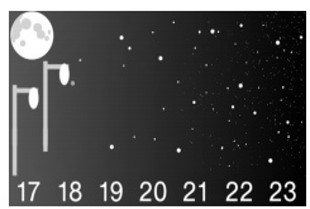The Sky Quality Meter (SQM) is a very powerful handheld device for measuring twilight and is produced by the Canadian company Unihedron.
A number of models are available and for the Tayba Trust Dawn Observation project, the USB enabled data-logging light meter was used which allowed for continuous automatic recording of night-time sky brightness.
The SQM measures the brightness of the night sky in magnitudes per square arcsecond (MPAS). This is a logarithmic measurement where large changes in sky brightness correspond to relatively small numerical changes. This allows for illumination changes to be measured on a simple scale and attributed as follows:

A magnitudes per square arcsecond (MPAS) reading of 17 to 18 corresponds the the light conditions you may experience when the moon is full or with street lights. The higher the scale the darker the sky with smaller stars becoming visible when the MPAS exceeds 20. What the SQM allows us to do is track the levels of light as it gets darker after sunset, establish the length of the night when the light level remain relatively constant and see the point at which the sky starts to become brighter and the MPAS reading start to decrease as dawn approaches, all independently of the depression angle of the sun.
The SQM is more sensitive than the human eye and can register very small changes in light as shown in the following examples:
Example 1 : Near perfect Conditions
The chart shows the point at which the MPAS reaches 10 as it gets darker after sunset and then levels off when all twilight is gone and the sky is dark (black), known in Islam as Shafaq al-Abyad. In the shown example the MPAS readings level-off at around 20 MPAS and remain around this level until the following morning. At a given point, the MPAS readings begin to decrease indicating a light source (Sun) is making the sky brighter. We refer this is point as the 'Tipping Point' in our study. As the SQM is more sensitive than the human eye, this does not indicate the actual time of Subh al-Sadiq (dawn) but does indicate dawn does not occur before this point regardless of the altitude of the sun at this point. The MPAS readings for this near perfect example results in a smooth curve.
[Click Image to Expand]
Example 2: Impact of Weather
In this example, the presence of moving clouds results in refraction of twilight from both the clouds and potentially any rain drops. Even in scenario the SQM data supports the analyst of when Isha (Shafaq al-Abyad) starts, the length of the night and the point at which Subh al-Sadiq (dawn) can occur after.
[Click Image to Expand]
Example 3: Moonlight
In this example the MPAS readings remain low (between 16 and 17) for the majority of the light whilst the moonlight illuminates the night sky. At the point the moon sets, the MPAS reading increase as the sky gets darker and this level of twilight remains until the 'Tipping' point after which Subh al-Sadiq (dawn) occurs.
[Click Image to Expand]
Advantages of using the SQM ?
It may be counterintuitive, but the main strength of the SQM, is its ability to clearly show when Subh al-Sadiq (dawn) is not occurring. The SQM support the exploration of the first point at which the rising sun still below the horizon begins the affect the level of light (twilight) above the horizon and hence an observable dawn cannot be occurring before this point regardless of the depsression angle the sun has reached (e.g 18°). This combined with naked eye observations allowed the project to define the parameters for Subh al-Sadiq (dawn).
SQM use in establish Shafaq al-Abyad (Isha) ?
Although it was not in the original remit of the project, the SQM data has supported the establishment of when all influence of the setting sun has gone and the sky is as dark as it will get. Again this results in a very powerful argument independent of the depressison angle of the sun for setting the time at which Shafaq al-Abyad (Isha) occurs.



